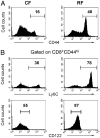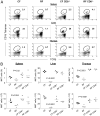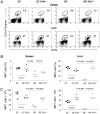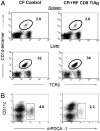Commensal microbiota and CD8+ T cells shape the formation of invariant NKT cells
- PMID: 20048124
- PMCID: PMC3458428
- DOI: 10.4049/jimmunol.0902620
Commensal microbiota and CD8+ T cells shape the formation of invariant NKT cells
Abstract
Commensal bacteria play an important role in formation of the immune system, but the mechanisms involved are incompletely understood. In this study, we analyze CD1d-restricted invariant NKT (iNKT) cells in germfree mice and in two colonies of C57BL/6 mice termed conventional flora and restricted flora (RF), stably bearing commensal microbial communities of diverse but distinct composition. In germfree mice, iNKT cells were moderately reduced, suggesting that commensal microbiota were partially required for the antigenic drive in maintaining systemic iNKT cells. Surprisingly, even greater depletion of iNKT cell population occurred in RF mice. This was in part attributable to reduced RF levels of intestinal microbial taxa (Sphingomonas spp.) known to express antigenic glycosphingolipid products. However, memory and activated CD8(+) T cells were also expanded in RF mice, prompting us to test whether CD8(+) T cell activity might be further depleting iNKT cells. Indeed, iNKT cell numbers were restored in RF mice bearing the CD8alpha(-/-) genotype or in adult wild-type RF mice acutely depleted with anti-CD8 Ab. Moreover, iNKT cells were restored in RF mice bearing the Prf1(-/-) phenotype, a key component of cytolytic function. These findings indicate that commensal microbiota, through positive (antigenic drive) and negative (cytolytic depletion by CD8(+) T cells) mechanisms, profoundly shape the iNKT cell compartment. Because individuals greatly vary in the composition of their microbial communities, enteric microbiota may play an important epigenetic role in the striking differences in iNKT cell abundance in humans and therefore in their potential contribution to host immune status.
Figures







Similar articles
-
Systemic control of plasmacytoid dendritic cells by CD8+ T cells and commensal microbiota.J Immunol. 2008 May 1;180(9):5843-52. doi: 10.4049/jimmunol.180.9.5843. J Immunol. 2008. PMID: 18424703 Free PMC article.
-
Pathogen-expanded CD11b+ invariant NKT cells feedback inhibit T cell proliferation via membrane-bound TGF-β1.J Autoimmun. 2015 Apr;58:21-35. doi: 10.1016/j.jaut.2014.12.006. Epub 2015 Jan 13. J Autoimmun. 2015. PMID: 25592391
-
Essential role for autophagy during invariant NKT cell development.Proc Natl Acad Sci U S A. 2014 Dec 30;111(52):E5678-87. doi: 10.1073/pnas.1413935112. Epub 2014 Dec 15. Proc Natl Acad Sci U S A. 2014. PMID: 25512546 Free PMC article.
-
The interaction between invariant Natural Killer T cells and the mucosal microbiota.Immunology. 2018 Oct;155(2):164-175. doi: 10.1111/imm.12958. Epub 2018 Jul 11. Immunology. 2018. PMID: 29893412 Free PMC article. Review.
-
Commensal microbial regulation of natural killer T cells at the frontiers of the mucosal immune system.FEBS Lett. 2014 Nov 17;588(22):4188-94. doi: 10.1016/j.febslet.2014.06.042. Epub 2014 Jun 28. FEBS Lett. 2014. PMID: 24983499 Review.
Cited by
-
Invariant natural killer T cells: an innate activation scheme linked to diverse effector functions.Nat Rev Immunol. 2013 Feb;13(2):101-17. doi: 10.1038/nri3369. Epub 2013 Jan 21. Nat Rev Immunol. 2013. PMID: 23334244 Review.
-
Bugging inflammation: role of the gut microbiota.Clin Transl Immunology. 2016 Apr 15;5(4):e72. doi: 10.1038/cti.2016.12. eCollection 2016 Apr. Clin Transl Immunology. 2016. PMID: 27195115 Free PMC article. Review.
-
Immunometabolic Activation of Invariant Natural Killer T Cells.Front Immunol. 2018 May 28;9:1192. doi: 10.3389/fimmu.2018.01192. eCollection 2018. Front Immunol. 2018. PMID: 29892305 Free PMC article. Review.
-
Insights Into Mucosal-Associated Invariant T Cell Biology From Studies of Invariant Natural Killer T Cells.Front Immunol. 2018 Jun 28;9:1478. doi: 10.3389/fimmu.2018.01478. eCollection 2018. Front Immunol. 2018. PMID: 30013556 Free PMC article. Review.
-
How the insect immune system interacts with an obligate symbiotic bacterium.Proc Biol Sci. 2011 Feb 7;278(1704):333-8. doi: 10.1098/rspb.2010.1563. Epub 2010 Aug 18. Proc Biol Sci. 2011. PMID: 20719775 Free PMC article.
References
-
- Savage DC. Microbial ecology of the gastrointestinal tract. Annu Rev Microbiol. 1977;31:107–133. - PubMed
-
- Conway PL. Microbial ecology of the human large intestine. In: Gibson GR, editor. Human Colonic Bacteria: Role in Nutrition, Physiology, And Pathology. CRC Press; Boca Raton, FL: 1995. pp. 1–24.
-
- Mackie RI, Sghir A, Gaskins HR. Developmental microbial ecology of the neonatal gastrointestinal tract. Am J Clin Nutr. 1999;69:1035S–1045S. - PubMed
Publication types
MeSH terms
Substances
Grants and funding
- AI52031/AI/NIAID NIH HHS/United States
- GM07185/GM/NIGMS NIH HHS/United States
- CA016042/CA/NCI NIH HHS/United States
- DK69434/DK/NIDDK NIH HHS/United States
- DK349870/DK/NIDDK NIH HHS/United States
- DK46763/DK/NIDDK NIH HHS/United States
- R01 DK069434/DK/NIDDK NIH HHS/United States
- T32 GM007185/GM/NIGMS NIH HHS/United States
- R01 AI078885/AI/NIAID NIH HHS/United States
- AI69296/AI/NIAID NIH HHS/United States
- P01 DK046763/DK/NIDDK NIH HHS/United States
- R01 AI069296/AI/NIAID NIH HHS/United States
- T32 AI052031/AI/NIAID NIH HHS/United States
- P30 CA016042/CA/NCI NIH HHS/United States
LinkOut - more resources
Full Text Sources
Other Literature Sources
Molecular Biology Databases
Research Materials
Miscellaneous

